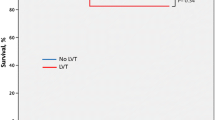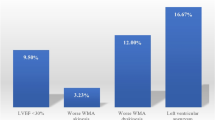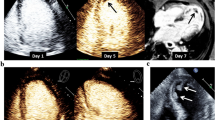Abstract
We aimed to characterize the independent predictors of LVT following STEMI and the association with outcomes. The clinical predictors of left ventricular thrombus (LVT) formation after ST-segment elevation myocardial infarction (STEMI) are not well-defined in the contemporary era. We performed a retrospective analysis of STEMI patients at Duke from 2000 to 2011 who had a transthoracic echocardiogram within 90 days post-STEMI and compared patients with and without LVT (LVT+ vs. LVT−). Univariate Cox proportional hazards regression models of baseline characteristics were examined and significant variables were used in a multivariable model to assess adjusted relationships with LVT. A multivariable Cox PH survival model with covariate adjustments was used for assessment of LVT and long-term mortality. Of all eligible patients, 1734 patients met inclusion criteria and 4.3 % (N = 74) had a LVT. LVT+ patients tended to have a history of heart failure (HF) and higher initial troponin compared to LVT- patients. After adjustment, higher heart rate, non-white race, HF severity, and presence of left anterior descending artery (LAD) disease were independent predictors of LVT. There was a trend toward an association between LVT and increased all-cause mortality (HR 1.36; 95 % CI 0.84–2.21, P = 0.22), however this was not statistically significant. LVT was seen in over 4 % of this contemporary post-STEMI population. Several baseline characteristics were independently associated with LVT: Heart rate, HF severity, LAD disease, and non-white race. Prospective studies are warranted to determine whether anticoagulation in patients at increased risk for LVT improves outcomes.



Similar content being viewed by others
Abbreviations
- LVT:
-
Left ventricular thrombus
- HF:
-
Heart failure
- AMI:
-
Acute myocardial infarction
- STEMI:
-
ST-segment elevation myocardial infarction
- TTE:
-
Transthoracic echocardiogram
- PCI:
-
Percutaneous coronary intervention
- EF:
-
Ejection fraction
- IQR:
-
Interquartile range
- DDCD:
-
Duke Databank for Cardiovascular Disease
References
Crawford TC et al (2004) Prognostic usefulness of left ventricular thrombus by echocardiography in dilated cardiomyopathy in predicting stroke, transient ischemic attack, and death. Am J Cardiol 93(4):500–503
Weinsaft JW et al (2008) Detection of left ventricular thrombus by delayed-enhancement cardiovascular magnetic resonance prevalence and markers in patients with systolic dysfunction. J Am Coll Cardiol 52(2):148–157
Asinger RW et al (1981) Incidence of left-ventricular thrombosis after acute transmural myocardial infarction. Serial evaluation by two-dimensional echocardiography. N Engl J Med 305(6):297–302
Jugdutt BI, Sivaram CA (1989) Prospective two-dimensional echocardiographic evaluation of left ventricular thrombus and embolism after acute myocardial infarction. J Am Coll Cardiol 13(3):554–564
Keren A et al (1990) Natural history of left ventricular thrombi: their appearance and resolution in the posthospitalization period of acute myocardial infarction. J Am Coll Cardiol 15(4):790–800
Visser CA et al (1983) Left ventricular thrombus following acute myocardial infarction: a prospective serial echocardiographic study of 96 patients. Eur Heart J 4(5):333–337
Delewi R, Zijlstra F, Piek JJ (2012) Left ventricular thrombus formation after acute myocardial infarction. Heart 98(23):1743–1749
Ascione L et al (2002) Relation between early mitral regurgitation and left ventricular thrombus formation after acute myocardial infarction: results of the GISSI-3 echo substudy. Heart 88(2):131–136
Chiarella F et al (1998) Predischarge two-dimensional echocardiographic evaluation of left ventricular thrombosis after acute myocardial infarction in the GISSI-3 study. Am J Cardiol 81(7):822–827
Delewi R et al (2012) Left ventricular thrombus formation after acute myocardial infarction as assessed by cardiovascular magnetic resonance imaging. Eur J Radiol 81(12):3900–3904
Solheim S et al (2010) Frequency of left ventricular thrombus in patients with anterior wall acute myocardial infarction treated with percutaneous coronary intervention and dual antiplatelet therapy. Am J Cardiol 106(9):1197–1200
Shacham Y et al (2013) Frequency and correlates of early left ventricular thrombus formation following anterior wall acute myocardial infarction treated with primary percutaneous coronary intervention. Am J Cardiol 111(5):667–670
Zielinska M, Kaczmarek K, Tylkowski M (2008) Predictors of left ventricular thrombus formation in acute myocardial infarction treated with successful primary angioplasty with stenting. Am J Med Sci 335(3):171–176
Gianstefani S et al (2014) Incidence and predictors of early left ventricular thrombus after ST-elevation myocardial infarction in the contemporary era of primary percutaneous coronary intervention. Am J Cardiol 113:1111–1116
Osherov AB et al (2009) Incidence of early left ventricular thrombus after acute anterior wall myocardial infarction in the primary coronary intervention era. Am Heart J 157(6):1074–1080
Harris PJ et al (1980) Outcome in medically treated coronary artery disease. Ischemic events: nonfatal infarction and death. Circulation 62(4):718–726
Velazquez EJ et al (2012) Survival in Patients with Moderate or Severe Mitral Regurgitation at High Risk for Surgery Treated With and Without the MitraClip: A Propensity Matched Comparison. J Am Coll Cardiol 59(13):A490
Boyle CA, Decoufle P (1990) National sources of vital status information: extent of coverage and possible selectivity in reporting. Am J Epidemiol 131(1):160–168
Thygesen K et al (2012) Third universal definition of myocardial infarction. J Am Coll Cardiol 60(16):1581–1598
Wagner GS (2007) Marriott’s practical electrocardiography, 11th edn. Lippincott Williams & Wilkins, Philadelphia
Sgarbossa EB et al (1996) Electrocardiographic diagnosis of evolving acute myocardial infarction in the presence of left bundle-branch block. GUSTO-1 (Global Utilization of Streptokinase and Tissue Plasminogen Activator for Occluded Coronary Arteries) investigators. N Engl J Med 334(8):481–487
O’Gara PT et al (2013) ACCF/AHA guideline for the management of ST-elevation myocardial infarction: a report of the American College of Cardiology Foundation/American Heart Association Task Force on Practice Guidelines. J Am Coll Cardiol 61(4):e78–e140
Rehan A et al (2006) Incidence of post myocardial infarction left ventricular thrombus formation in the era of primary percutaneous intervention and glycoprotein IIb/IIIa inhibitors. A prospective observational study. Cardiovasc Ultrasound 4:20
Weinsaft JW et al (2011) LV thrombus detection by routine echocardiography: insights into performance characteristics using delayed enhancement CMR. JACC Cardiovasc Imaging 4(7):702–712
Mentz RJ et al (2012) Comparison of clinical characteristics and long-term outcomes of patients with ischemic cardiomyopathy with versus without angina pectoris (from the Duke Databank for Cardiovascular Disease). Am J Cardiol 109(9):1272–1277
Gale CP et al (2014) Trends in hospital treatments, including revascularisation, following acute myocardial infarction, 2003–2010: a multilevel and relative survival analysis for the National Institute for Cardiovascular Outcomes Research (NICOR). Heart 100(7):582–589
McManus DD et al (2011) Recent trends in the incidence, treatment, and outcomes of patients with STEMI and NSTEMI. Am J Med 124(1):40–47
Rogers WJ et al (2008) Trends in presenting characteristics and hospital mortality among patients with ST elevation and non-ST elevation myocardial infarction in the National Registry of Myocardial Infarction from 1990 to 2006. Am Heart J 156(6):1026–1034
Go AS et al (2014) Executive summary: heart disease and stroke statistics–2014 update: a report from the american heart association. Circulation 129(3):399–410
Rabbani LE et al (2008) Determinants of left ventricular thrombus formation after primary percutaneous coronary intervention for anterior wall myocardial infarction. J Thromb Thrombolysis 25(2):141–145
Srichai MB et al (2006) Clinical, imaging, and pathological characteristics of left ventricular thrombus: a comparison of contrast-enhanced magnetic resonance imaging, transthoracic echocardiography, and transesophageal echocardiography with surgical or pathological validation. Am Heart J 152(1):75–84
Weinsaft JW et al (2009) Contrast-enhanced anatomic imaging as compared to contrast-enhanced tissue characterization for detection of left ventricular thrombus. JACC Cardiovasc Imaging 2(8):969–979
Kressin NR, Petersen LA (2001) Racial differences in the use of invasive cardiovascular procedures: review of the literature and prescription for future research. Ann Intern Med 135(5):352–366
Gregory PM et al (1999) Impact of availability of hospital-based invasive cardiac services on racial differences in the use of these services. Am Heart J 138(3 Pt 1):507–517
Fincher C et al (2004) Racial disparities in coronary heart disease: a sociological view of the medical literature on physician bias. Ethn Dis 14(3):360–371
Edelstein LC et al (2013) Racial differences in human platelet PAR4 reactivity reflect expression of PCTP and miR-376c. Nat Med 19:1609–1616
Pendyala LK et al (2013) Racial disparity with on-treatment platelet reactivity in patients undergoing percutaneous coronary intervention. Am Heart J 166(2):266–272
Crimm A et al (1984) Prognostic significance of isolated sinus tachycardia during first three days of acute myocardial infarction. Am J Med 76(6):983–988
Galcera Tomas J (1999) Incidence, clinical characteristics and prognostic significance of supraventricular tachyarrhythmias in acute myocardial infarction. Rev Esp Cardiol 52(9):647–655
Schmitt J et al (2009) Atrial fibrillation in acute myocardial infarction: a systematic review of the incidence, clinical features and prognostic implications. Eur Heart J 30(9):1038–1045
Pizzetti F et al (2001) Incidence and prognostic significance of atrial fibrillation in acute myocardial infarction: the GISSI-3 data. Heart 86(5):527–532
Gottdiener JS et al (1983) Frequency and embolic potential of left ventricular thrombus in dilated cardiomyopathy: assessment by 2-dimensional echocardiography. Am J Cardiol 52(10):1281–1285
Sharma ND et al (2000) Left ventricular thrombus and subsequent thromboembolism in patients with severe systolic dysfunction. Chest 117(2):314–320
Nikolsky E et al (2012) Outcomes of patients treated with triple antithrombotic therapy after primary percutaneous coronary intervention for ST-elevation myocardial infarction (from the Harmonizing Outcomes With Revascularization and Stents in Acute Myocardial Infarction [HORIZONS-AMI] trial). Am J Cardiol 109(6):831–838
Funding
No extramural funding. Mentz, R: supported by Grant Number 5-T32GM086330 from the National Institute of General Medical Sciences. Fiuzat, M and O’Connor, C: Roche Diagnostics—research Grants; Velazquez, E: Consulting Fees/Honoraria: Novartis Pharmaceuticals Corp.; Research/Research Grants: Ikaria Pharmaceuticals; supported by grants from the National Institute of Health.
Author information
Authors and Affiliations
Corresponding author
Additional information
Dr. Garber completed the project while working at Duke, finished the manuscript after taking new position at VCU.
Rights and permissions
About this article
Cite this article
Garber, A.M., Mentz, R.J., Al-Khalidi, H.R. et al. Clinical predictors and outcomes of patients with left ventricular thrombus following ST-segment elevation myocardial infarction. J Thromb Thrombolysis 41, 365–373 (2016). https://doi.org/10.1007/s11239-015-1252-0
Published:
Issue Date:
DOI: https://doi.org/10.1007/s11239-015-1252-0




